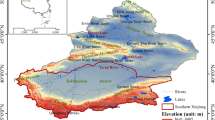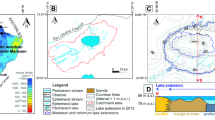Abstract
Devils Lake, a terminal saline lake in eastern North Dakota, has experienced catastrophic flooding over the past two decades producing direct damages in excess of $1 billion ($USD). We use three long-term datasets to examine the temporal coherence between historical lake fluctuations and basic hydroclimatic drivers. Monthly precipitation and mean monthly air temperature data are used to characterize long-term precipitation delivery and evaporative demand. Monthly water balance data for a representative location are used to assess basin soil moisture conditions. A lake volume time series documents lake volume fluctuation in response to long-term precipitation and regional soil moisture conditions. Three variables are derived from the datasets, each characterizing a different aspect of the region’s hydroclimatology. A rescaling technique is applied to each variable to examine the temporal coherence and relative patterns of the variables and to identify distinct homogeneous hydroclimatic regimes during the historical period. The three rescaled variables show strong temporal coherence and confirm 1980 as an abrupt transition year between two distinct long-term hydroclimatic modes. Mode 1, a longer and drier phase, runs from 1907 to 1980, while mode 2, a shorter and wetter phase, extends from 1981 to the present. Multi-decadal and century-scale fluctuations between these two modes are the key drivers of long-term lake volume fluctuations, upon which interannual- and interdecadal-scale climatic variability are superimposed. The similar rates of change among the rescaled variables provides evidence in support of the conclusion that long-term natural hydroclimatological variability is the primary driver of observed lake volume changes at Devils Lake during the Twentieth Century and provides a foundation upon which to evaluate the potential contributing effects of anthropogenic climate change, and human alterations of the land use hydrology.







Similar content being viewed by others
References
Benito G, Lang M, Barriendos M, Llasat MC, Francés F, Ouarda T, Thorndycraft VR, Enzel Y, Bardossy A, Coeur C, Bobée B (2004) Use of systematic, palaeoflood and historical data for the improvement of flood risk estimation. Review of scientific methods. Nat Hazards 31:623–643
Bluemle JP (1995) The fluctuating level of Devils Lake. North Dakota Geological Survey. Newsletter 22:7–9
Bluemle JP, Sabel JM, Karlén W (1999) Rate and magnitude of past global climate changes. Environ Geosci 6:63–75
Crimmins SM, Dobrowski SZ, Greenberg JA, Abatzoglou JT, Mynsberge AR (2011) Changes in climatic water balance drive downhill shifts in plant species’ optimum elevations. Science 331:324–327
Daly C, Halbleib M, Smith JI, Gibson WP, Doggett MK, Taylor GH, Curtis J, Pasteris PP (2008) Physiographically sensitive mapping of climatological temperature and precipitation across the conterminous United States. Int J Climatol 28:2031–2064
Drummond MA, Auch RF, Karstensen KA, Sayler KL, Taylor JL, Loveland TR (2012) Land change variability and human-environment dynamics in the United States Great Plains. Land Use Policy 29:710–723
Ehsanzadeh E, van der Kamp G, Spence C (2012) The impact of climatic variability and change in the hydroclimatology of Lake Winnipeg watershed. Hydrol Process 26:2802–2813
Fritz SC, Ito E, Yu Z, Laird KR, Engstrom DR (2000) Hydrologic variation in the northern Great Plains during the last two millennia. Quat Res 53:175–184
Garbrecht JD, Rossel FE (2002) Decade-scale precipitation increase in Great Plains at end of 20th Century. J Hydrol Eng 7:64–75
Garbrecht J, Van Liew M, Brown GO (2004) Trends in precipitation, streamflow, and evapotranspiration in the Great Plains of the United States. J Hydrol Eng 9:360–367
Grundstein A (2008) Assessing climate change in the contiguous United States using a modified Thornthwaite climate classification scheme. Prof Geogr 60:398–412
Haskell BJ, Engstrom DR, Fritz SC (1996) Late Quaternary paleohydrology in the North American Great Plains inferred from the geochemistry of endogenic carbonate and fossil ostracodes from Devils Lake, North Dakota, USA. Palaeogeogr Palaeoclimatol Palaeoecol 124:179–193
Hay LE, McCabe GJ (2002) Spatial variability in water-balance model performance in the conterminous United States. J Am Water Resour As 38:847–860
Hoerling M, Eischeid J, Easterling D, Peterson T, Webb R (2010) Understanding and explaining hydro-climate variations at Devils Lake. Unpublished NOAA climate assessment prepared for the interagency initiative to address flooding issues at Devils Lake, ND
Jensen RE (1972) Climate of North Dakota. North Dakota State Water Commission, Bismarck
Kluver D, Leathers D (2015) Regionalization of snowfall frequency and trends over the contiguous United States. Int J Climatol. doi:10.1002/joc.4292
Laird KR, Cumming BF, Wunsam S, Rusak JA, Oglesby RJ, Fritz SC, Leavitt PR (2003) Lake sediments record large-scale shifts in moisture regimes across the northern prairies of North America during the past two millennia. Proc Natl Acad Sci 100:2483–2488
Larson D (2012) Runaway Devils Lake. Am Sci 100:46–53
Mason IM, Guzkowska MAJ, Rapley CG, Street-Perrott FA (1994) The response of lake levels and areas to climatic change. Clim Change 27:161–197
McCabe GJ, Markstrom SL (2007) A monthly water-balance model driven by a graphical user interface. US Geological Survey Open-File Report 2007–1088. United States Geological Survey, Denver
McCabe GJ Jr, Wolock DM (2002) Trends and temperature sensitivity of moisture conditions in the conterminous United States. Clim Res 20:19–29
McCabe GJ Jr, Wolock DM (2014) Spatial and temporal patterns in conterminous United States streamflow characteristics. Geophys Res Lett. doi:10.1002/2014GL061980
McCabe GJ Jr, Palecki MA, Betancourt JL (2004) Pacific and Atlantic Ocean influences on multidecadal drought frequency in the United States. Proc Natl Acad Sci 101:4136–4141
Mohammed IN, Tarboton DG (2011) On the interaction between bathymetry and climate in the system dynamics and preferred levels of the Great Salt Lake. Water Resour Res. doi:10.1029/2010WR009561
Outcalt SI, Hinkel KM, Meyer E, Brazel AJ (1997) Application of Hurst Rescaling to geophysical serial data. Geogr Anal 29:72–87
Rosenberg NJ (1986) Climate of the Great Plains Region of the United States. Gt Plains Quart 7:22–32
Rosenberry DO (2003) Climate of the Cottonwood Lake area. In: Winter TC (ed) Hydrological, chemical, and biological characteristics of a prairie pothole wetland complex under highly variable climate conditions: the Cottonwood Lake area, east-central North Dakota, US Geological Survey Professional Paper 1675. USGS, Denver, pp 25–34
Runnalls KE, Oke TR (2006) A technique to detect microclimatic inhomogeneities in historical records of screen-level air temperature. J Clim 19:959–978
Ryan GL, Wiche GJ (1988) Hydrology of the Chain of Lakes Tributary to Devils Lake and Water-Level Simulations of Devils Lake, Northeastern North Dakota. US Geological Survey Water-Resources Investigations Report 88-4020. United States Geological Survey, Bismarck
Ryberg KR, Lin W, Vecchia AV (2014) Impact of climate variability on runoff in the North-Central United States. J Hydrol Eng 19:148–158
Sankarasubramanian A, Vogel RM (2003) Hydroclimatology of the continental United States. Geophys Res Lett 30:1363. doi:10.1029/2002GL015937
Schilling KE, Chan K-S, Liu H, Zhang Y-K (2010) Quantifying the effect of land use land cover change on increasing discharge in the Upper Mississippi River. J Hydrol 387:343–345
Sethre PR, Rundquist BC, Todhunter PE (2005) Remote detection of prairie pothole ponds in the Devils Lake Basin of North Dakota. GISc Rem Sens 42:277–296
Shapley MD, Johnson WC, Engstrom DR, Osterkamp WR (2005) Late-Holocene flooding and drought in the Northern Great Plains, USA, reconstructed from tree rings, lake sediments and ancient shorelines. Holocene 15:29–41
Shaw DA, van der Kamp G, Conly FM, Pietroniro A, Mertz L (2012) The fill-spill hydrology of prairie wetland complexes during drought and deluge. Hydrol Process 26:3147–3156
Shook KR, Pomeroy JW (2011) Memory effects of depressional storage in Northern Prairie hydrology. Hydrol Process 25:3890–3898
Small D, Islam S, Vogel RM (2006) Trends in precipitation and streamflow in the eastern US: paradox or perception? Geophys Res Lett 33:L03403. doi:10.1029/2005GL024995
Stockton CW (1990) Climatic variability on the scale of decades to centuries. Clim Change 16:172–183
Street FA (1980) The relative importance of climate and local hydrogeological factors in influencing lake-level fluctuations. Palaeoecol Afr 12:137–158
Todhunter PE (2012) Uncertainty of the assumptions required for estimating the regulatory flood: Red River of the North. J Hydrol Eng 17:1011–1020
Todhunter PE, Knish EA (2014) Lake flooding and synoptic weather-type frequency at Devils Lake, North Dakota between 1965 and 2010. Clim Res 61:191–201
Todhunter PE, Rundquist BC (2004) Terminal lake flooding and wetland expansion in Nelson County, North Dakota. Phys Geogr 25:68–85
Todhunter PE, Rundquist BC (2008) Pervasive wetland flooding in the glacial drift prairie of North Dakota (USA). Nat Hazards 46:73–88
Tomer MD, Schilling KE (2009) A simple approach to distinguish land-use and climate-change effects on watershed hydrology. J Hydrol 376:24–33
United States Geological Survey (2013) USGS 05056500 Devils Lake nr Devils Lake, ND. http://nwis.waterdata.usgs.gov/nd/nwis/nwisman? Accessed 15 Nov 2013
United States Geological Survey (2014) Devils Lake and Stump Lake Area-Capacity Table. http://nd.water.usgs.gov/devilslake/pdf/elevation-area-volume.pdf. Accessed 18 Feb 2014
Vecchia AV (2008) Climate simulation and flood risk analysis for 2008-40 for Devils Lake, North Dakota. US Geological Survey Scientific Investigations Report 2008-5011. United States Geological Survey, Denver
Wiche G (1986) Hydrologic and climatologic factors affecting water levels of Devils Lake, North Dakota. Water-Resources Investigations Report 86-4320. United States Geological Survey, Bismarck
Wiche GJ (1992) Hydrology and water-level fluctuations of Devils Lake, North Dakota. US Geological Survey Water-Supply Paper 2340. United States Geological Survey, Denver
Wiche GJ, Pusc SW (1994) Hydrology of Devils Lake Area, North Dakota. North Dakota State Water Commission Water Resources Investigation 22. North Dakota State Water Commission, Bismarck
Wilhite DA, Glantz MH (1985) Understanding the drought phenomenon: the role of definitions. Water Int 10:111–120
Williams WD (1996) What future for saline lakes? Environment 38(13–20):38–39
Williams WD (1998) Management of Inland Saline waters. Guidelines of lake management Vol. 6. International Lake Environment Committee, United Nations Environment Programme
Wolock DM, McCabe GJ (1999) Explaining spatial variability in mean annual runoff in the conterminous United States. Clim Res 11:149–159
Woodhouse CA, Russell JL, Cook ER (2009) Two modes of North American drought from instrumental and paleoclimatic data. J Clim 22:4336–4347
Zhang Y-K, Schilling KE (2006) Increasing streamflow and baseflow in Mississippi River since the 1940s: effect of land use change. J Hydrol 324:412–442
Zheng H, Barta D, Zhang X (2014) Lessons learned from adaptation response to Devils Lake flooding in North Dakota, USA. Reg Environ Change 14:185–194
Acknowledgments
We thank Rick Thalacker for his work in making Fig. 1. The careful reading and constructive comments from three anonymous reviewers is gratefully acknowledged.
Author information
Authors and Affiliations
Corresponding author
Rights and permissions
About this article
Cite this article
Todhunter, P.E., Fietzek-DeVries, R. Natural hydroclimatic forcing of historical lake volume fluctuations at Devils Lake, North Dakota (USA). Nat Hazards 81, 1515–1532 (2016). https://doi.org/10.1007/s11069-015-2143-6
Received:
Accepted:
Published:
Issue Date:
DOI: https://doi.org/10.1007/s11069-015-2143-6




